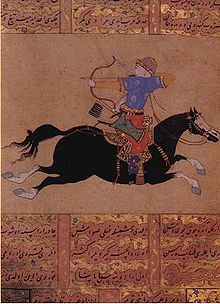Parthian maneuver

The Parthian maneuvers (often called Partherschuss called) is a bow shooting technique , in which the horse archer in full gallop to back up. It is named after the Iranian people of the Parthians .
execution
On suitable terrain , the Parthian maneuver created a tactical advantage and enabled large armies with mounted archers to maintain the desired distance and keep the initiative in battle when attacking less mobile troops, such as the legions of Rome . The enemy formations were often broken up by this maneuver, as the attacked units assumed that the enemy would flee and they were chasing the supposedly easy victim. Now the pursuer either continued to be shot at or was involved in close combat . Since the pursuer usually no longer proceeded in orderly formations for quick pursuit, it was easier to overpower him. This could be done using flank maneuvers .
There are different views of the execution: some sources show the rider standing in the stirrups and facing backwards, others show the rider sitting in the saddle and turning backwards. Since the technology has been used repeatedly throughout history, both representations should be correct. The maneuver required exceptional riding skill and body control, as the hands had to remain free for the bow shot and the horse could only be steered by applying pressure from the thighs.
Use in different peoples
The Parthian maneuver is a technique that was used by the Scythians , Sarmatians and Parthians, later also by the Huns and Mongols in Mongolian warfare and other Asian steppe peoples , and was perfected after the invention of the stirrup. This procedure is described, for example, in Plutarch's report on the defeat of Marcus Licinius Crassus against the Parthians in the Battle of Carrhae .